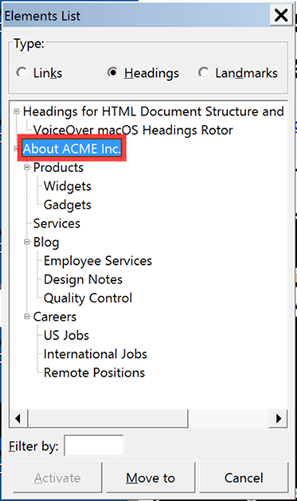I think the talk of how ARIA fits into this is getting a little muddied. I want to clarify a few key points:
-
The algorithm being proposed is not an outline algorithm. It replaces some of the intended purpose of the outline algorithm, but it does not produce an outline as output. It's better thought of as an "effective heading level" algorithm. It takes an element in the DOM as input, and produces its effective heading level as output. Heading levels are an output, not an input, and no heading is affected by the level of any other heading. So whether it considers ARIA does not make much difference. The ARIA override is applied after this algorithm produces its result.
-
In the amended proposal, the effective heading level would be exposed directly to CSS via the
:heading()pseudo-class. For implementation complexity and layering reasons, ARIA can't play into this CSS selector. So something has to define the effective heading level pre-ARIA-override. -
For purposes of what is exposed to assistive technology, accessibility mappings take the output of the effective heading level algorithm as the default. However, if the same element has
aria-levelon it, then assistive technologies get that level instead. -
This is actually the normal way ARIA works for everything else. Many elements in HTML have a default accessibility mapping. However, ARIA markup always takes precedence at the accessibility layer, but does not directly affect the rendering, behavior or non-accessibility semantics. This is due to ARIA's origin as a solution for "div soup" style JavaScript frameworks that do not use semantic markup. So, for example, at the HTML and CSS levels, only
<input type=checkbox>is a checkbox, and it always is one. But at the assistive technology mapping level, that is the default, and ARIA takes precedence. For assistive technology mapping purposes,<div role=checkbox>is a checkbox, and<input type=checkbox role=banner>is not. -
Why would an author intentionally make the assistive technology mapping of an element conflict with its base semantics? The fact is, most of the time, they should not. It's better to use correct semantic markup in the first place and be consistent at all layers. But the purpose of ARIA is to give authors the override switch for the cases where it gives the best outcome.
In conclusion, I think a layered approach is correct. HTML should define an "effective heading level" algorithm as proposed by @annevk. That would get exposed directly to the proposed :heading() pseudo-class. Then, HTML Accessibility Mappings would take that as the default, and let ARIA be an override at the accessibility mapping layer.
In fact, HTML AAM is already kind of set up this way. HTML AAM links to Core AAM's language on conflicts to say that ARIA role and heading level always overrides this for purposes of accessibility. But in 4.4 Element Role Mappings, it says h1-h6 elements default to a heading level of the element's outline depth, as defined in current HTML.
Unfortunately, this is widely ignored, because the way "outline depth" is defined is not practical to implement. It always gives the wrong answer for elements not in a section; it says that an h3 outside a section has an outline depth of 1, for example.
If HTML provides a new definition of effective heading level", then it will be very easy to fit it into the architecture of existing accessibility specs. HTML AAM simply needs to replace its reference to "outline depth" with one to "effective heading level", and all the layers will hook together correctly.
Trying to consider ARIA when computing the effective heading level in the first place will not be a good fit. It will cause ARIA to get applied twice, at two different layers, and would not match how ARIA works for other elements.
(Sorry for the long-winded explanation. This is a bit complicated and subtle to explain. I hope the explanation was helpful for some people.)


Currently the HTML standard does not provide any advice in regards to the outline algorithm not being implemented, This has lead to some developers believing that the outline algorithm has an effect in browsers and assitive technology which it does not. THis can lead to developers using markup patterns that don't convey document structure. Suggest adding a warning, for example this is the warning in the W3C HTML spec